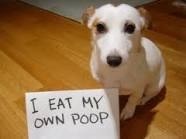 PetSitters Identifying Cat Litter ProblemsPosted on March 22, 2013a cat and a Litter box (Photo credit: Wikipedia) This blog is from a colleague who specializes in cat sitting. She has many colorful experiences with cats. And is also a passionate expert on cat litter. It’s a great read . And I learned a lot myself. Our Pet Sitters Identify Litter Box ProblemsRelated articles Share this:
 By: Tanya S. Last month I wrote a blog called “ Why Do Dogs Eat Poop?!. It’s a mystical phenomenon that many of us do not understand . This month is a follow up . I will give you solutions to help deter this gross habit that the fur baby we are in love with has. I decided to post this because I’ve had many clients, as of late as well as professional pet sitters asking me for solutions. I will share some of my homemade solutions as well as solutions from professionals in the pet care industry . HOMEMADE DETERRENTSThe more common sense approach to deterring your dog from eating poop is to make it taste bad. Lets see what’s in our house that will help us with this solution . 1) Where as lemon juice and hot sauce are great health benefits to us( master cleanse diet) coating these ingredients in stool is a very bad taste. 2). How many of us love pumpkin pie, pumpkin cake or just fresh pumpkin? Mm Mmm delicious . Yet coating two tablespoons into feces, yuck yuck yuck to the palate. 3) For all you meat lovers , share that meat tenderizer in your dog’s food. By the time it comes out as excrement , it leaves a very bad taste to make your dog think twice. FROM A VETERINARIAN‘S POINT OF VIEW1) When a dog begins to eat poop, that’s a big red flag that they are are not getting the nutrients needed from their diet. Switch to a healthier diet for your pet’s sake. You can cook or buy quality food that is formulated for the dog’s age, breed and any medical issues. Check out our food by Flint River Ranch. 2) Coprophagia is also a sign he’s not eating enough. Increase the amount of nutritious food your dog is eating . Flint River Ranch had good quality that you can feed with out the worry of weight gain. 3) Take your fur baby to your veterinarian for an examination for underlying medical and health problems, parasites and other problems that may be compelling him to eat feces. 4) Stop the access to poop. There are many reasons we encourage pet owners to have doggy bags or a pooper scooper while walking. It not only keeps our neighborhoods clean but it stops the access of feces. 5) Walk your dog more and give him better exercise regimen . During the walks you can train him and control his proximity to other feces on the ground. Don’t have the time for those walking routines and know it’s necessary? Call us, Happy Walk Happy Dog for daily mid-day walks and daily twice a day walks/run. 6) As soon as your dog starts approaching excrement, tell her ‘nah-ah-ahhh’ or ‘leave it!’, and distract her with praise supported with a treat, clicker click, playtime or other action or activity that is appealing to the dog. This will convey the idea that it is more rewarding to attend to you than to attend to poop. As soon as she turns her attention to her, praise her (‘Good dog!’) and reward her. A wise practice is to always carry appealing tidbit treats, a favorite toy, clicker – something you can always use to effectively gain your dog’s attention and reinforce desired behaviors. Once you get her attention, give her something positive to do. For example, tell her to ‘Sit’, reward her for listening, then proceed to an enjoyable activity such as playing or walking together. Distract her from undesired things like feces, and substitute a good, desired behavior such as sitting and attending to you. A dog who is interacting with her owner can’t be investigating poop at the same time. 7) If your baby is pooping in the house, it’s another reason to call Happy Walk Happy Dogto get them on a regular schedule and decrease the loneliness. I hope these tips help all of you to deal with the issue of Coprophagia and resolve it. Til Next Time….
 A day or two ago, I wrote in my blog, Scoop the Poop about how my heart was torn because I had to let go of a rescue dog I recently adopted. He was over aggressive , scared my pets and me as well because he has an unpredictable temper and he bites. It was the main reason he was placed in the shelter. The Northeast Georgia Humane society has been great because they kept him alive and put him in training with a behaviorist. I was another in line to adopt this pet who thought I would be able to handle him and his temper with the love and attention I would shower him. Well he awoke me from my fantasy and I recognized it was too much for me to handle. I felt ashamed because I pride myself on being able to handle and care for any dog. Yet I recognized that I had to let him go. I only did it after realizing that the NE GA Humane Society and I discussed his next steps and the extensive training he will go through with a behaviorist. I felt comfortable because I could tell they genuinely cared for him and his life like I did. The blog:( When Is The Time To Give Up On An Aggressive Dog ) While contemplating if I should let him go, one of the determining issues was the legal aspect. What if he had bitten the dog clients I have in my house, my parents, my boyfriend’s parents or the kids? That’s plenty of lawsuits we couldn’t afford. So it was the right thing to do. Today I read an article dealing with this exact issue and I want to share it with you. It’s called : How to Limit Your Liability If Your Dog BitesTil Next Time…
5 Health Mistakes Dog Owners Make
Feature by Wendy C. Fries
Sometimes, pet owners with the best of intentions still make serious mistakes when it comes to the health of their dog.
Here's what top veterinarians had to say about mistakes owners make that lead to ailments they often see and how you can avoid them.
Mistake 1: Not Getting Preventive Care
Houston’s Canine Health Institute associate medical director Adrianne Brode, DVM, says neglecting preventive health care is the most common mistake dog owners make.
"Taking your dog in to the vet for regular examinations, giving heartworm prevention, and getting your dog the appropriate vaccinations and deworming can prevent many diseases," Brode says. For example, heartworm disease can be difficult to treat and ultimately fatal to dogs, but it's easily preventable.
Oregon veterinarian Marla J. McGeorge, DVM, says yearly exams help your vet catch problems early. Instead of coping with lengthy treatment of an advanced or chronic condition, your vet can catch issues in their beginning stages when care may mean cure. Early care saves you money in the long run.
5 Health Mistakes Dog Owners Make
ShareAA
Mistake 1: Not Getting Preventive Care continued...
Simply getting your dog vaccinated isn't the same as a full physical exam. Among other things, a comprehensive checkup may include:
Blood work
A fecal examination for intestinal parasites
Examination of a dog’s gums, heart, lungs, teeth, eyes, and ears
Talk to your veterinarian to learn more.
Mistake 2: Neglecting Dental Care
Shawn Messonnier, DVM, author of the Natural Health Bible for Dogs and Cats, says neglecting regular dental care is also common. Dogs need dental care for the same reason we do: to prevent gum disease.
As with human teeth, plaque forms on a dog's teeth after eating. If left alone, the plaque builds, causing inflammation, decay, and eventually bone and tooth loss. And while this silent war goes on in your dog's mouth, she’s probably experiencing pain you don't notice because dogs, like cats, instinctively hide pain.
Gum disease is five times more common in dogs than it is in people. But it's easy to prevent and to treat with dental care that includes:
Daily brushings
Good quality food
Regular oral X-rays, exams, and cleanings
Safe teeth-cleaning treats and chew toys
Mistake 3: Overfeeding
If too much love is ever a bad thing, it's when we show it in the form of too many tasty treats. "Rewarding and loving our dogs with food leads to obesity," Brode says. Overweight or obese dogs are at higher risk for arthritis and other orthopedic issues as well as other health problems.
It can be difficult enough to balance your own diet let alone that of your dog. Your vet can help you select a good, high-quality food for your dog and give you tips on exercise and treats. You don't have to stop sharing occasional goodies with your pooch, as long as 90% to 95% of your dog's diet is healthy and well balanced.
Mistake 4: Sharing Medication
Another dangerous health mistake owners make is giving dogs human medications. "Pain medications like Advil or Tylenol can be very toxic to dogs," Brode says. In addition, there is a host of seemingly benign human drugs that can pose grave health risks for pets.
Nonsteroidal anti-inflammatory drugs (NSAIDs), such as ibuprofen, are the most common cause of pet poisoning in small animals, according to the ASPCA. Even small doses can be toxic. Antidepressants, muscle relaxers, decongestants, vitamin D derivatives, oral diabetes treatments, and other common human drugs can all pose risks to pets, ranging from seizures to coma to death.
Always keep medication secure -- preferably in a high, locked cabinet -- and never discard medication where pets or children can get to it. If you’re worried that your dog may have gobbled up an over-the-counter or prescription pill you dropped -- or worse, taken an entire bottle from the trash -- don't hesitate. Immediately call the Animal Poison Control Center 24-hour hotline at (888) 426-4435.
Mistake 5: Delaying Critical Care
We often delay medical care for ourselves, waiting for a bump, pain, or rash to go away. So it may seem natural to do the same thing with our dog.
Unfortunately, dogs don't have the words to let us know exactly what they're feeling. Your canine companion could be in pain, sick, and even gravely ill -- and chances are you wouldn't know it because of dogs’ instinct to hide infirmity.
Don't wait to see if a health problem in your dog gets better on its own. Call your vet if your dog isn't eating or is eating less, is vomiting, seems lethargic, has diarrhea or fever, or just doesn't seem well.
TRAINING
3 Reasons It's a Must to Read Your Dog's Body Language
Dogs communicate with their faces, ears, eyes, eyebrows, tails -- their entire bodies. Over the years, I have learned to “listen” to my dogs, to the extent possible.
By: Ann Allums
In December, I thought it would be fun to get a picture of my dogs with Santa. A local pet-friendly establishment was offering photos, and when it was our turn, I walked my dogs, Sylvie and Sarge, toward the man in the red suit.
The author with Sarge and Sylvie.
Sylvie approached Santa with a loose body, relaxed wagging tail, and open mouth, her ears in a neutral position. Her body language said she was comfortable. On the other hand, Sarge’s body language communicated a different message. He cautiously approached with his head and tail lowered, and with his mouth closed, and as he got closer, the hair on his back raised. Sarge was saying, “I’m not comfortable with this strange bearded person in a furry suit.”
My “jolly routine” (speaking in an upbeat, happy manner) didn’t affect his emotional state, so rather than allow my dog to continue to be stressed and pushing him to accept something he was wary of, I calmly escorted my dogs away.
Sylvie kisses Sarge. They're both comfortable with this.
An important part of responsible pet ownership is understanding your dog’s body language. Dogs communicate with their faces, ears, eyes, eyebrows, tails -- their entire bodies. I have learned to “listen” to my dogs, to the extent possible, in every interaction with other dogs and people, including with myself. Here are several reasons for the importance of understanding dog body-language.
1. Understanding body language can keep everyone safe
We should understand dog body-language to help keep ourselves, our dogs, and other people and dogs safe. Every dog has the equivalent of a dangerous weapon in their mouth -- teeth. How they wield that weapon is affected by their genetics, environment, and training. Regardless, it is vital that we be able to read a dog to prevent and avoid potential conflict.
When Sarge’s hackles went up, I immediately felt a sense of urgency to diffuse the potential conflict. Rather than react in emotion, such as nervously apologizing to Santa or, worse, yelling at Sarge (which would just add more anxiety to the situation), I cheerily called Sarge to me (which we have practiced hundreds of times) and redirected him away from the situation. Not that Sarge has ever bitten, but I never want to push him into a situation where he felt like he didn’t have another other option. What if Santa had made a sudden movement, or moved his hand toward Sarge? With a dog already in an emotional state of caution, anything could tip the scales into further defensive action on the part of the dog.
Sarge visiting people at an assisted living center. He's smiling and relaxed here, unlike with Santa.
There was a time when I misunderstood dog body-language and I missed the precursors of aggressive behavior, which later developed into a serious behavior problem. Had I been aware that my dog was feeling uncomfortable or behaving defensively, I could have addressed the root of the problem with help from a trainer before the behavior escalated. Trainer Sara Reusche writes, “When a dog bites, he’s often told us in every way he could how upset he was, and been ignored. Sometimes a bite is the only way he has of letting us know what’s wrong.”
2. It can reduce stress
It is important to understand your dog’s body language so that he is not exposed to unnecessary amounts of stress. Just as with people, stress in dogs can cause health and behavioral problems.
Sylvie's yawn may indicate she's stressed.
There are many specific ways that dogs display stress: a yawn, a lip lick, sweaty paws, dilated pupils, freezing, food refusal. When I recognize these signs, I try to determine the cause of the stress and possibly deal with it through training or management to help my dogs relax. Through training, I can help my dog change his underlying emotional reaction toward something or someone, and through management, I can minimize my dog’s stressors.
3. It helps with communication
Understanding your dog’s body language is key to your relationship with your dog. Relationships are built on and sustained by communication. Communication goes both ways -- we should strive to “listen” to our dogs just as we want our dogs to listen to us. When my dog shakes off after I hug him, I should be aware that I just did something that made him uncomfortable. When entering a new place, if I notice that my dog suddenly moves slowly and has muscle bulges by his mouth and eye, I may have to adjust my pace or plans for the benefit of my dog.
Sylvie relaxes in the flowers.
Keep in mind that to dogs, vocal communication is secondary to body language, that is, they primarily communicate by body language. In dog training, we have a term called "trainer babble." These are all the words that dogs tune out, because they can only focus on so much at a time. If you are moving and talking at the same time, your dog is responding more to your body movement than to your words, because the movement is more salient, meaning it will overshadow your words.
Sarge, hanging out calmly at the assisted living center.
There are many good resources available for learning about the rich and complex language of dogs. Stanley Coren explains in his wonderful book How To Speak Dog about the multi-faceted forms of canine communication, and includes his version of a "Doggish Phrasebook." An excellent DVD on the subject is called What Is My Dog Saying? by Carol Byrnes.
The more we understand dog body-language, the better we will understand and appreciate these remarkable creatures.
Focus on the Positive
by Leah Roberts, Dog Willing Positive Training Solutions.
If your dog is behaving in a way you don't like, instead of asking, “How do I stop this?” the question should be “What would I like him to do instead?” All behavior has a purpose. First, determine what the dog gets out of the behavior. Then teach him a behavior you can accept to ask for what he wants.
For example, is he barking for attention? Teach him to come and sit in front of you with eye contact to ask for attention. Or does she beg for food at the table? Teach her to lie on a mat with a chewy during dinner and reward her with a tidbit from your plate when you are finished.
When your dog is behaving politely, make sure you reinforce him in a timely manner! It's easy to forget to acknowledge a dog who is sitting or lying down quietly. That will create a frustrated dog who doesn't know how to communicate with you and he will be likely to revert back to the unwanted behavior.
Does your dog bark or growl and lunge at other dogs while you’re walking him on a leash?
This is a very common problem in under-socialized, nervous or anxious dogs. Immediately when your dog sees another dog and barks, he gets an adrenaline reward. Not only are bark-and-lunge explosions stressful for you, but also for your dog. In addition, from your dog’s point of view the aggressive display seems to work pretty well–after all, the other dog always goes away.
That means every time your dog blows up, he becomes a little likelier to try the same tactic next time. So until you can get good professional help, keep your dog out of trouble as much as you can. Dogs have but two options. Flight or Fight: Flight is to run away or avoid, but this isn’t an option when on lead. So the only option left is to fight, by barking and acting aggressively.
It’s best for your dog to avoid encounters altogether by teaching him to ignore other dogs completely when walking on leash, unless specifically stopped on cue, told to sit, and stay and wait for permission to approach and greet. The absolutely more problematic, most difficult way for dogs to meet and greet is on leash.
Once a dog’s mind passes a certain level of arousal, he can’t hear you, everything is oblivious except the other dog. At his peak he may as well be deaf, will not eat treats and does not feel any tugging on the leash. He has become possessed.
He can’t learn a new behavior at his peak of arousal; his learning environment needs to be in your yard absent of any distractions.
If your dog could act naturally and calmly around other dogs he would. But, he must be taught in the quiet of your own home and yard, without distractions. Dogs need active behaviors they can perform in place of their usual bad behavior.
As you begin modifying his behavior, consider the following:
Treatment depends on how established this problem has become.
Teaching your dog to focus on you is vital.
Your dog should learn that when he’s on leash, he should walk past and ignore other dogs. There is no reason to meet and greet.
Teach a desirable alternate behavior. So it can’t be just the absence of the bad behavior, as dogs don’t understand voids. You need to give him something else to do instead.
The new behavior must be ingrained into your dog’s head for at least several weeks before expecting him to be able to listen to you in the presence of another dog at a distance.
Reward the calm before the storm. Reward your dog before the barking starts and he may be able to happily walk past the distraction without reacting at all. By praising quiet, you may avoid noise all together.
Act the way you want your dog to act. If you want him to be relaxed, calm and happy – move, speak and touch him as if you are relaxed, calm and happy.
Try a Head Halter. These can be helpful when used properly and make on-leash management much easier on the dog and human. The way to use most head halters is to use a smooth upward pressure to stop forward movement and to help redirect the dog. Release all pressure immediately when the dog sits or calms.
Don’t set your dog up for failure. If you can avoid a situation that is likely to be a problem, avoid it. Turn around and go a different direction, walk a different route, or walk at a time of day when you won’t encounter your dog’s trigger. Repeating failure won’t help your dog improve.
Choke collars, pinch collars, and shock collars are designed to stop dogs from barking by causing pain. The dog might stop barking because it hurts, but this won’t decrease the dog’s frustration. In fact, the association with pain can cause the dog to DISLIKE other dogs and ultimately behave AGGRESSIVELY toward other dogs.
With patience, redirection, and praise, your dog can learn how to act appropriately when encountering other dogs during his walk.
|









 RSS Feed
RSS Feed